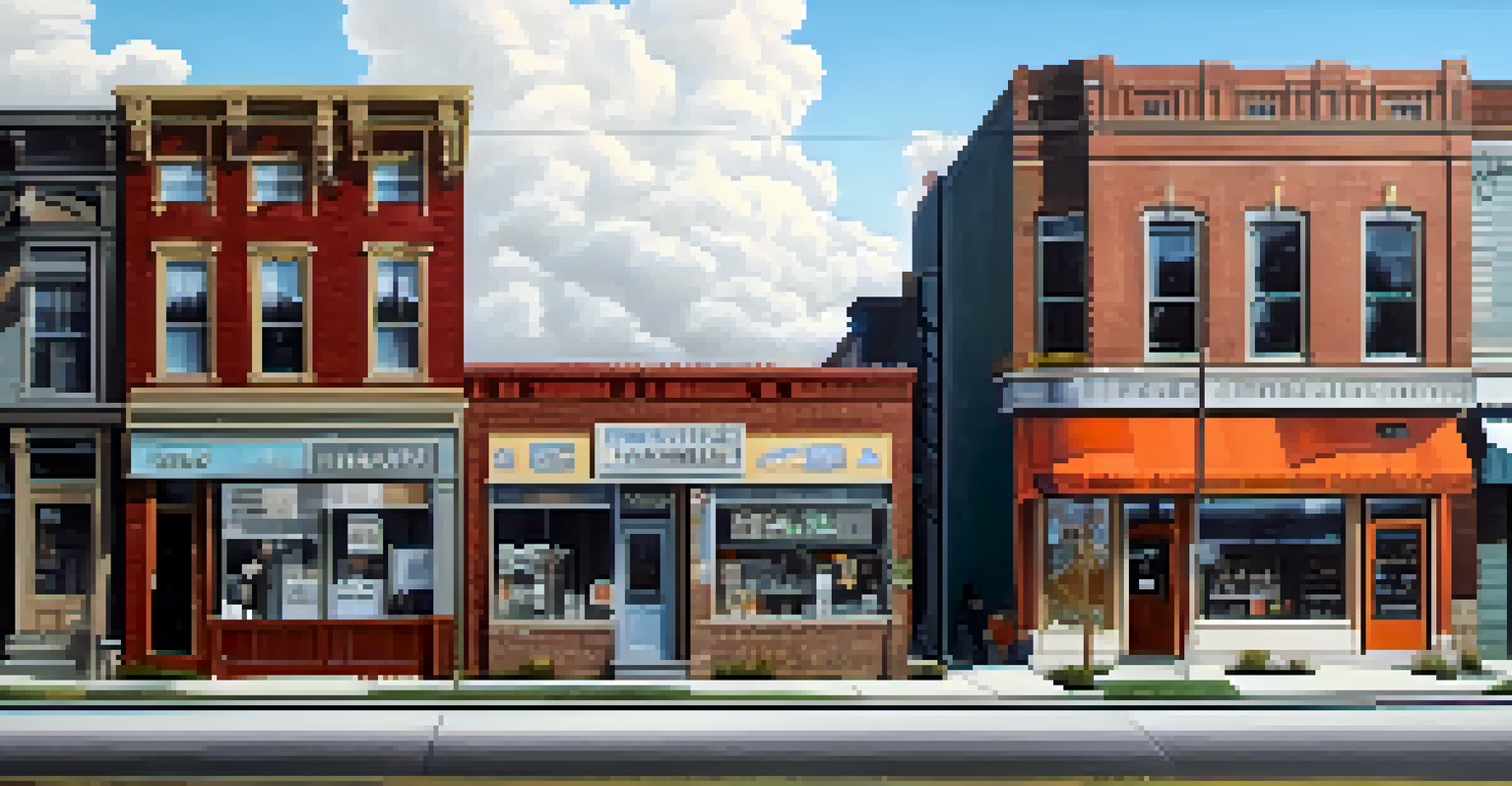Gentrification and Its Effects on Los Angeles Communities

Defining Gentrification and Its Roots in Los Angeles
Gentrification is a complex process that involves the transformation of neighborhoods, often characterized by an influx of more affluent residents. In Los Angeles, this phenomenon has historical roots, stemming from urban renewal efforts and the desire for revitalization. As property values rise, long-standing community members may find themselves displaced, leading to significant changes in the cultural fabric of neighborhoods.
Gentrification is a complex process that involves the transformation of neighborhoods, often characterized by an influx of more affluent residents.
Historically, areas such as Boyle Heights and Echo Park have seen waves of gentrification, driven by the appeal of their unique character and proximity to downtown. These neighborhoods, once home to diverse communities, are now attracting higher-income individuals seeking affordable housing near urban amenities. This shift often brings about a clash of cultures, as new residents and established locals navigate their coexistence.
Understanding gentrification requires a look at the socio-economic factors at play, including investment patterns and government policies. As developers invest in these areas, the needs and voices of long-term residents can become overshadowed, leading to tensions and misunderstandings. This dynamic creates a need for thoughtful dialogue and community engagement to address the concerns of all stakeholders.
The Positive Aspects of Gentrification
On the surface, gentrification can bring several benefits to communities, including improved infrastructure and increased economic activity. New businesses, restaurants, and shops often emerge, enhancing the vibrancy of neighborhoods and creating jobs. This influx of investment can lead to better public services, such as parks and transportation options, which can benefit all residents.

Additionally, as property values rise, homeowners may find their investments appreciating, providing them with financial security. This scenario can lead to a more stable community where people are encouraged to invest in their homes and neighborhoods. The aesthetic revitalization of once-neglected areas can also foster a sense of pride among residents, both old and new.
Gentrification Displaces Residents
As neighborhoods gentrify, long-term residents often face displacement due to rising rents and housing costs.
However, it's crucial to recognize that while these benefits are noteworthy, they often come at a cost. The challenge lies in balancing development with the preservation of community identity and affordability. Striking this balance requires proactive measures to ensure that the developments serve the needs of all residents, not just the newcomers.
Negative Consequences for Displaced Residents
One of the most significant negative consequences of gentrification is the displacement of long-term residents. As rents soar and housing becomes unaffordable, many families are forced to relocate, often to areas with fewer resources and opportunities. This leads to a heartbreaking loss of community ties, as neighbors who have lived side by side for years are suddenly uprooted.
Displacement is not just a physical relocation; it also carries emotional and psychological impacts.
Displacement is not just a physical relocation; it also carries emotional and psychological impacts. Families may lose access to their support networks, cultural landmarks, and local businesses that have been part of their lives for decades. The sense of belonging that comes from being part of a community can be shattered, leaving individuals feeling isolated and marginalized.
Moreover, the loss of affordable housing can exacerbate existing social inequalities. Lower-income families often struggle to find suitable housing in the face of rising costs, which can lead to increased homelessness and a lack of stability. As these families are pushed out, the neighborhood's diversity diminishes, impacting the rich cultural tapestry that once defined it.
Cultural Changes and Community Identity
Gentrification dramatically alters the cultural landscape of neighborhoods, often leading to the erasure of long-standing community identities. As new businesses catering to wealthier clientele emerge, the unique character of these areas can be overshadowed. For example, traditional eateries and shops may close, replaced by trendy cafes and boutiques that cater to a different demographic.
This cultural shift can create tension between newcomers and existing residents, as differing values and lifestyles clash. Established community members may feel alienated or unwelcome in their own neighborhoods, leading to a sense of loss and frustration. The challenge lies in fostering an environment where diverse cultures can coexist and thrive without one overpowering the other.
Community Identity at Risk
Gentrification can erase the unique cultural identities of neighborhoods, leading to tensions between new and established residents.
To counteract these effects, community engagement and inclusive development practices are essential. Initiatives that involve local voices in decision-making can help ensure that the cultural heritage of neighborhoods is preserved. By celebrating the unique aspects of communities, gentrification can be approached in a way that respects and honors the history and identity of all residents.
Economic Disparities and Access to Resources
Gentrification often highlights existing economic disparities, as wealthier residents move into historically lower-income neighborhoods. This influx can lead to a stark divide between those who can afford rising costs and those who cannot. While new businesses may thrive, the original residents may struggle to keep up with increasing prices, creating a divide that can be difficult to bridge.
Access to essential resources, such as healthcare, education, and transportation, can also become unevenly distributed. As wealthier residents move in, priorities may shift towards catering to their needs, potentially neglecting the concerns of long-time community members. This can lead to a situation where the very services that once supported a diverse population are no longer accessible to everyone.
Addressing these disparities requires a multi-faceted approach, including policy changes that prioritize affordable housing and equitable access to services. By ensuring that all residents can benefit from neighborhood improvements, communities can work towards a more inclusive future. Collaborative efforts between city officials, developers, and residents are essential to creating an environment that truly serves everyone.
Community Resistance and Activism
In response to the challenges posed by gentrification, many communities in Los Angeles have mobilized to resist displacement and advocate for their rights. Grassroots organizations and local activists have emerged, working tirelessly to raise awareness about the impacts of gentrification. They play a vital role in bringing residents together, providing support, and amplifying their voices in the conversation.
Activism can take many forms, from organizing community meetings to engaging in protests aimed at protecting affordable housing. These efforts serve not only to resist displacement but also to foster solidarity among residents facing similar struggles. By standing together, communities can push back against the tide of gentrification and advocate for policies that prioritize their needs.
Policy Influences Gentrification Effects
Government policies, such as zoning laws and affordable housing initiatives, significantly shape the impact of gentrification in communities.
Moreover, community resistance often leads to creative solutions that address the concerns of all stakeholders. Participatory budgeting and community land trusts are just a few examples of initiatives that empower residents to take control of their neighborhoods. Through collective action, communities can work towards a future that balances development with the preservation of their homes and identities.
The Role of Policy in Shaping Gentrification
Government policies play a crucial role in shaping the dynamics of gentrification in Los Angeles. Zoning laws, tax incentives, and urban planning decisions can either exacerbate or mitigate the effects of gentrification. For instance, policies that encourage affordable housing development can help counteract the displacement of long-time residents, while those that favor luxury developments may accelerate gentrification.
Additionally, inclusionary zoning policies, which require developers to include a percentage of affordable units in new projects, can create more equitable housing options. Such policies aim to ensure that all residents, regardless of income, have a place in the neighborhoods they call home. However, the effectiveness of these policies often depends on community engagement and advocacy efforts to hold officials accountable.

As the conversation around gentrification continues, it is essential for policymakers to consider the voices of affected communities. By prioritizing the needs of long-time residents and promoting inclusive development practices, Los Angeles can work towards a future that respects its diverse history while embracing positive change. Ultimately, the goal should be to create neighborhoods where everyone feels welcome and valued.